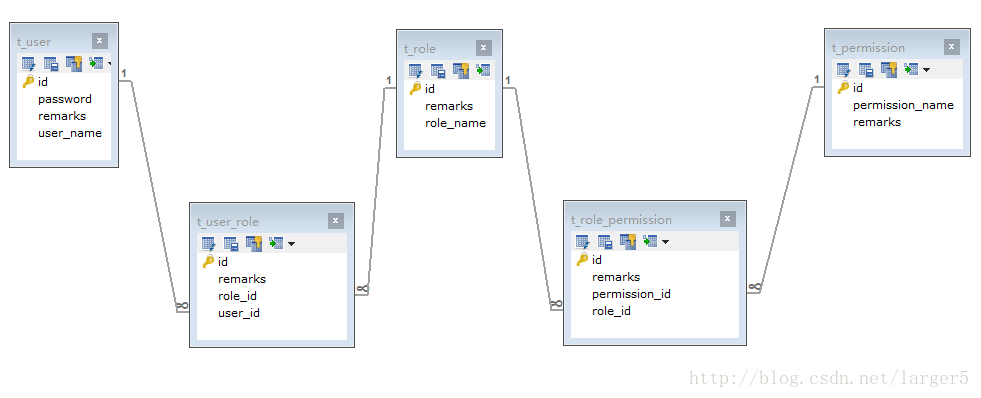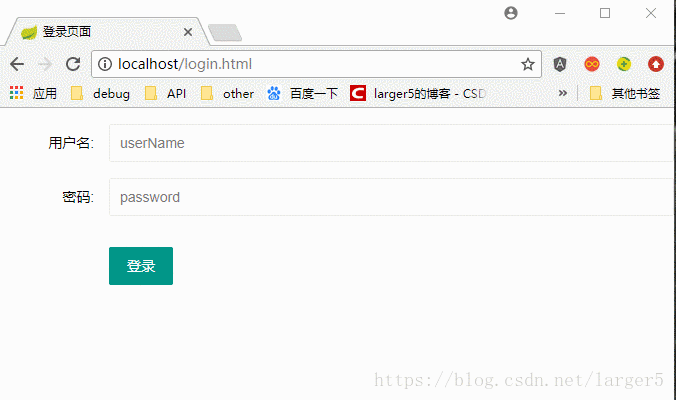使用 Shiro 设计基于用户、角色、权限的通用权限管理系统
一、前言

在大型的信息管理系统中,经常涉及到权限管理系统
下面来个 demo,很多复杂的系统的设计都来自它
代码已经放到github上了,地址:https://github.com/larger5/shiro_urp.git
2018.4.3 版本0.5 在 SpringBoot 中使用 Shiro+MySQL 做登录拦截
2018.4.6 版本1.0 使用 Shiro 设计基于用户、角色、权限的通用权限管理系统
以后继续更新,如用户、角色、权限 CRUD 等,真正做到所谓的权限管理系统
二、数据库表的设计
下面使用 SpringBoot + JPA 的,自动生成如下的表
用户角色多对多、角色权限多对多,设计一个通用的权限系统(无论初衷是一个用户多个角色还是一个角色)

三、效果
说明:
①UI:
使用了 LayUI 简单优化一下界面
②角色所含权限:
p:select
ip:select、insert
vip:select、insert、update、delete
③权限:
select
insert
update
delete
以使用 itaem (VIP)为例

图解:
有:① select、insert、update、delete 权限 ② vip 角色
无:ip角色、p角色,点击后都是没有反应的
四、代码(github 平台上看)
① Controller(重点)
package com.cun.controller;
import java.util.HashMap;
import java.util.Map;
import javax.servlet.http.HttpSession;
import javax.validation.Valid;
import org.apache.shiro.SecurityUtils;
import org.apache.shiro.authc.UsernamePasswordToken;
import org.apache.shiro.authz.annotation.RequiresPermissions;
import org.apache.shiro.authz.annotation.RequiresRoles;
import org.apache.shiro.subject.Subject;
import org.springframework.validation.BindingResult;
import org.springframework.web.bind.annotation.PostMapping;
import org.springframework.web.bind.annotation.RequestMapping;
import org.springframework.web.bind.annotation.RestController;
import com.cun.entity.User;
import springfox.documentation.swagger2.annotations.EnableSwagger2;
@EnableSwagger2
@RestController
@RequestMapping("/user")
public class UserController {
@PostMapping("/login")
public Map<String, Object> login(@Valid User user, BindingResult bindingResult, HttpSession session) {
Map<String, Object> map = new HashMap<String, Object>();
// 1、JSR303
if (bindingResult.hasErrors()) {
map.put("success", false);
map.put("errorInfo", bindingResult.getFieldError().getDefaultMessage());
return map;
}
// 2、Shiro
Subject subject = SecurityUtils.getSubject();
UsernamePasswordToken token = new UsernamePasswordToken(user.getUserName(), user.getPassword());
try {
subject.login(token);
map.put("success", true);
return map;
} catch (Exception e) {
e.printStackTrace();
map.put("success", false);
map.put("errorInfo", "用户名或者密码错误!");
return map;
}
}
④ ShiroConfig(重点)
package com.cun.config;
import java.util.LinkedHashMap;
import java.util.Map;
import org.apache.shiro.spring.LifecycleBeanPostProcessor;
import org.apache.shiro.spring.security.interceptor.AuthorizationAttributeSourceAdvisor;
import org.apache.shiro.spring.web.ShiroFilterFactoryBean;
import org.apache.shiro.web.mgt.DefaultWebSecurityManager;
import org.springframework.aop.framework.autoproxy.DefaultAdvisorAutoProxyCreator;
import org.springframework.context.annotation.Bean;
import org.springframework.context.annotation.Configuration;
import org.springframework.context.annotation.DependsOn;
import org.apache.shiro.mgt.SecurityManager;
import com.cun.realm.MyRealm;
/**
* Shiro配置类
* @author linhongcun
*
*/
@Configuration
public class ShiroConfig {
/**
* ShiroFilterFactoryBean 处理拦截资源文件问题。
* 注意:单独一个ShiroFilterFactoryBean配置是或报错的,以为在
* 初始化ShiroFilterFactoryBean的时候需要注入:SecurityManager
*
* Filter Chain定义说明 1、一个URL可以配置多个Filter,使用逗号分隔 2、当设置多个过滤器时,全部验证通过,才视为通过
* 3、部分过滤器可指定参数,如perms,roles
*
*/
@Bean
public ShiroFilterFactoryBean shirFilter(SecurityManager securityManager) {
ShiroFilterFactoryBean shiroFilterFactoryBean = new ShiroFilterFactoryBean();
// 必须设置 SecurityManager
shiroFilterFactoryBean.setSecurityManager(securityManager);
// 如果不设置默认会自动寻找Web工程根目录下的"/login.jsp"页面
shiroFilterFactoryBean.setLoginUrl("/login.html");
// 拦截器.
Map<String, String> filterChainDefinitionMap = new LinkedHashMap<String, String>();
// 配置不会被拦截的链接 顺序判断
filterChainDefinitionMap.put("/static/**", "anon");
filterChainDefinitionMap.put("/user/login", "anon");
//测试权限用
filterChainDefinitionMap.put("/swagger-ui.html", "anon");
// 配置退出过滤器,其中的具体的退出代码Shiro已经替我们实现了
filterChainDefinitionMap.put("/logout", "logout");
// 过滤链定义,从上向下顺序执行,一般将 /**放在最为下边 :这是一个坑呢,一不小心代码就不好使了;
// ① authc:所有url都必须认证通过才可以访问; ② anon:所有url都都可以匿名访问
filterChainDefinitionMap.put("/**", "authc");
shiroFilterFactoryBean.setFilterChainDefinitionMap(filterChainDefinitionMap);
return shiroFilterFactoryBean;
}
@Bean
public SecurityManager securityManager() {
DefaultWebSecurityManager securityManager = new DefaultWebSecurityManager();
// 设置realm.
securityManager.setRealm(myRealm());
return securityManager;
}
/**
* 身份认证realm; (这个需要自己写,账号密码校验;权限等)
*
* @return
*/
@Bean
public MyRealm myRealm() {
MyRealm myRealm = new MyRealm();
return myRealm;
}
/**
* Shiro生命周期处理器
* @return
*/
@Bean
public LifecycleBeanPostProcessor lifecycleBeanPostProcessor() {
return new LifecycleBeanPostProcessor();
}
/**
* 开启Shiro的注解(如@RequiresRoles,@RequiresPermissions),需借助SpringAOP扫描使用Shiro注解的类,并在必要时进行安全逻辑验证
* 配置以下两个bean(DefaultAdvisorAutoProxyCreator(可选)和AuthorizationAttributeSourceAdvisor)即可实现此功能
* @return
*/
@Bean
@DependsOn({ "lifecycleBeanPostProcessor" })
public DefaultAdvisorAutoProxyCreator advisorAutoProxyCreator() {
DefaultAdvisorAutoProxyCreator advisorAutoProxyCreator = new DefaultAdvisorAutoProxyCreator();
advisorAutoProxyCreator.setProxyTargetClass(true);
return advisorAutoProxyCreator;
}
@Bean
public AuthorizationAttributeSourceAdvisor authorizationAttributeSourceAdvisor() {
AuthorizationAttributeSourceAdvisor authorizationAttributeSourceAdvisor = new AuthorizationAttributeSourceAdvisor();
authorizationAttributeSourceAdvisor.setSecurityManager(securityManager());
return authorizationAttributeSourceAdvisor;
}
}
⑤ MyRealm(重点)
package com.cun.realm;
import java.util.HashSet;
import java.util.List;
import java.util.Set;
import org.apache.shiro.SecurityUtils;
import org.apache.shiro.authc.AuthenticationException;
import org.apache.shiro.authc.AuthenticationInfo;
import org.apache.shiro.authc.AuthenticationToken;
import org.apache.shiro.authc.SimpleAuthenticationInfo;
import org.apache.shiro.authz.AuthorizationInfo;
import org.apache.shiro.authz.SimpleAuthorizationInfo;
import org.apache.shiro.realm.AuthorizingRealm;
import org.apache.shiro.subject.PrincipalCollection;
import org.springframework.beans.factory.annotation.Autowired;
import com.cun.dao.PermissionDao;
import com.cun.dao.RoleDao;
import com.cun.dao.UserDao;
import com.cun.entity.Permission;
import com.cun.entity.Role;
import com.cun.entity.User;
public class MyRealm extends AuthorizingRealm {
@Autowired
private UserDao userDao;
@Autowired
private RoleDao roleDao;
@Autowired
private PermissionDao permissionDao;
/**
* 授权
*/
@Override
protected AuthorizationInfo doGetAuthorizationInfo(PrincipalCollection principals) {
String userName=(String) SecurityUtils.getSubject().getPrincipal();
SimpleAuthorizationInfo info=new SimpleAuthorizationInfo();
Set<String> roles=new HashSet<String>();
List<Role> rolesByUserName = roleDao.getRolesByUserName(userName);
for(Role role:rolesByUserName) {
roles.add(role.getRoleName());
}
List<Permission> permissionsByUserName = permissionDao.getPermissionsByUserName(userName);
for(Permission permission:permissionsByUserName) {
info.addStringPermission(permission.getPermissionName());
}
info.setRoles(roles);
return info;
}
/**
* 认证
*/
@Override
protected AuthenticationInfo doGetAuthenticationInfo(AuthenticationToken token) throws AuthenticationException {
System.out.println("token.getPrincipal:" + token.getPrincipal());
System.out.println("token.getCredentials:" + token.getCredentials());
String userName = token.getPrincipal().toString();
User user = userDao.getUserByUserName(userName);
if (user != null) {
// Object principal, Object credentials, String realmName
AuthenticationInfo authcInfo = new SimpleAuthenticationInfo(user.getUserName(), user.getPassword(), getName());
return authcInfo;
} else {
return null;
}
}
}
五、其他
① sql
CREATE DATABASE /*!32312 IF NOT EXISTS*/`urp` /*!40100 DEFAULT CHARACTER SET utf8 */;
USE `urp`;
/*Table structure for table `t_permission` */
DROP TABLE IF EXISTS `t_permission`;
CREATE TABLE `t_permission` (
`id` int(11) NOT NULL AUTO_INCREMENT,
`permission_name` varchar(50) DEFAULT NULL,
`remarks` varchar(1000) DEFAULT NULL,
PRIMARY KEY (`id`)
) ENGINE=InnoDB AUTO_INCREMENT=5 DEFAULT CHARSET=utf8;
/*Data for the table `t_permission` */
insert into `t_permission`(`id`,`permission_name`,`remarks`) values (1,'select','查询'),(2,'insert','增加'),(3,'update','更新'),(4,'delete','删除');
/*Table structure for table `t_role` */
DROP TABLE IF EXISTS `t_role`;
CREATE TABLE `t_role` (
`id` int(11) NOT NULL AUTO_INCREMENT,
`remarks` varchar(1000) DEFAULT NULL,
`role_name` varchar(100) DEFAULT NULL,
PRIMARY KEY (`id`)
) ENGINE=InnoDB AUTO_INCREMENT=4 DEFAULT CHARSET=utf8;
/*Data for the table `t_role` */
insert into `t_role`(`id`,`remarks`,`role_name`) values (1,'普通角色','p'),(2,'重要角色','ip'),(3,'超级角色','vip');
/*Table structure for table `t_role_permission` */
DROP TABLE IF EXISTS `t_role_permission`;
CREATE TABLE `t_role_permission` (
`id` int(11) NOT NULL AUTO_INCREMENT,
`remarks` varchar(1000) DEFAULT NULL,
`permission_id` int(11) DEFAULT NULL,
`role_id` int(11) DEFAULT NULL,
PRIMARY KEY (`id`),
KEY `FKjobmrl6dorhlfite4u34hciik` (`permission_id`),
KEY `FK90j038mnbnthgkc17mqnoilu9` (`role_id`),
CONSTRAINT `FK90j038mnbnthgkc17mqnoilu9` FOREIGN KEY (`role_id`) REFERENCES `t_role` (`id`),
CONSTRAINT `FKjobmrl6dorhlfite4u34hciik` FOREIGN KEY (`permission_id`) REFERENCES `t_permission` (`id`)
) ENGINE=InnoDB AUTO_INCREMENT=8 DEFAULT CHARSET=utf8;
/*Data for the table `t_role_permission` */
insert into `t_role_permission`(`id`,`remarks`,`permission_id`,`role_id`) values (1,'授予普通角色select权限',1,1),(2,'授予重要角色select权限',1,2),(3,'授予重要角色insert权限',2,2),(4,'授予超级角色select权限',1,3),(5,'授予超级角色insert权限',2,3),(6,'授予超级角色update权限',3,3),(7,'授予超级角色delete权限',4,3);
/*Table structure for table `t_user` */
DROP TABLE IF EXISTS `t_user`;
CREATE TABLE `t_user` (
`id` int(11) NOT NULL AUTO_INCREMENT,
`password` varchar(100) NOT NULL,
`remarks` varchar(1000) DEFAULT NULL,
`user_name` varchar(100) NOT NULL,
PRIMARY KEY (`id`)
) ENGINE=InnoDB AUTO_INCREMENT=4 DEFAULT CHARSET=utf8;
/*Data for the table `t_user` */
insert into `t_user`(`id`,`password`,`remarks`,`user_name`) values (1,'123','JKing团队','jking'),(2,'123','网维团队','wteam'),(3,'123','ITAEM团队','itaem');
/*Table structure for table `t_user_role` */
DROP TABLE IF EXISTS `t_user_role`;
CREATE TABLE `t_user_role` (
`id` int(11) NOT NULL AUTO_INCREMENT,
`remarks` varchar(1000) DEFAULT NULL,
`role_id` int(11) DEFAULT NULL,
`user_id` int(11) DEFAULT NULL,
PRIMARY KEY (`id`),
KEY `FKa9c8iiy6ut0gnx491fqx4pxam` (`role_id`),
KEY `FKq5un6x7ecoef5w1n39cop66kl` (`user_id`),
CONSTRAINT `FKq5un6x7ecoef5w1n39cop66kl` FOREIGN KEY (`user_id`) REFERENCES `t_user` (`id`),
CONSTRAINT `FKa9c8iiy6ut0gnx491fqx4pxam` FOREIGN KEY (`role_id`) REFERENCES `t_role` (`id`)
) ENGINE=InnoDB AUTO_INCREMENT=4 DEFAULT CHARSET=utf8;
/*Data for the table `t_user_role` */
insert into `t_user_role`(`id`,`remarks`,`role_id`,`user_id`) values (1,'授予JKing团队普通角色',1,1),(2,'授予网维团队重要角色',2,2),(3,'授予ITAEM团队超级角色',3,3);
转载https://blog.csdn.net/larger5/article/details/79838212
使用 Shiro 设计基于用户、角色、权限的通用权限管理系统的更多相关文章
- 基于SSM框架的JavaWeb通用权限管理系统
- - ->关注博主公众号[C you again],获取更多IT资源(IT技术文章,毕业设计.课程设计系统源码,经典游戏源码,HTML网页模板,PPT.简历模板,!!还可以投稿赚钱!!,点击查 ...
- 基于Extjs 4.2的通用权限管理系统,通用后台模板,EF+MVC+Extjs 4.2
基于Extjs 4.2的通用权限管理系统,通用后台. 我们的宗旨:珍爱生命,拒绝重复!Don't Repeat Yourself!!! 本案例采用EntityFramework+MVC4.0+Extj ...
- 分享基于EF+MVC+Bootstrap的通用后台管理系统及架构
基于EF+MVC+Bootstrap构建通用后台管理系统,集成轻量级的缓存模块.日志模块.上传缩略图模块.通用配置及服务调用, 提供了OA.CRM.CMS的原型实例,适合快速构建中小型互联网及行业 ...
- 分享基于EF+MVC+Bootstrap的通用后台管理系统及架构(转)
http://www.cnblogs.com/guozili/p/3496265.html 基于EF+MVC+Bootstrap构建通用后台管理系统,集成轻量级的缓存模块.日志模块.上传缩略图模块.通 ...
- 基于EF+MVC+Bootstrap的通用后台管理系统及架构
分享基于EF+MVC+Bootstrap的通用后台管理系统及架构 基于EF+MVC+Bootstrap构建通用后台管理系统,集成轻量级的缓存模块.日志模块.上传缩略图模块.通用配置及服务调用, 提供了 ...
- Creating adaptive web recommendation system based on user behavior(设计基于用户行为数据的适应性网络推荐系统)
文章介绍了一个基于用户行为数据的推荐系统的实现步骤和方法.系统的核心是专家系统,它会根据一定的策略计算所有物品的相关度,并且将相关度最高的物品序列推送给用户.计算相关度的策略分为两部分,第一部分是针对 ...
- 课程设计-基于SSM的美容美发造型预约管理系统代码Java理发剪发设计造型系统vue美发店管理系统
注意:该项目只展示部分功能,如需了解,评论区咨询即可. 1.开发环境 开发语言:Java 后台框架:SSM 前端框架:vue 数据库:MySQL 设计模式:MVC 架构:B/S 源码类型: Web 编 ...
- jeesite快速开发平台(五)----用户-角色-部门-区域-菜单-权限表关系
转自: https://blog.csdn.net/u011781521/article/details/78994904
- SpringBoot整合Shiro实现基于角色的权限访问控制(RBAC)系统简单设计从零搭建
SpringBoot整合Shiro实现基于角色的权限访问控制(RBAC)系统简单设计从零搭建 技术栈 : SpringBoot + shiro + jpa + freemark ,因为篇幅原因,这里只 ...
随机推荐
- nginx全局查看进程
1. 查看nginx的PID,以常用的80端口为例: [root@rbtnode1 nginx-1.14.2]# netstat -anop | grep 0.0.0.0:80tcp 0 0 0.0. ...
- iview datepicker 选择的时间少一天
使用iview的datepicker时间选择器发现获取的value值是比实际要少一天,严格来说应该是时间格式不一样,datepicker获取的时间是UTC时间格式,也就是:yyyy-MM-ddTHH: ...
- CentOS 笔记(二) 端口占用,进程查看
①查看当前端口情况 netstat -nultp ②查看当前进程情况 ps -ef ps -ef|grep dotnet ③强制kill 进程 kill -9 [PIN]
- alg--分治法
分治--分而治之, 把大的问题分成n个小的问题,分别处理,然后汇总小问题的结果. 具体介绍可以参考这位大哥的blog: https://www.cnblogs.com/steven_oyj/archi ...
- 域名系统(DNS)
DNS (domain name server/system) 1.基本信息 网络中数据通信依赖ip地址 测试:手动将dns服务地址改为空值,通过ip和域名分别测试网络的联通性 FQDN 完全域名(完 ...
- SpringMVC在对应绑定不同实体,但具有相同属性名的解决方案....
在springmvc中,可以对前台传递过来的参数进行与后台实体绑定(第二种方式相对较好). 比如: 前台页面: <form action="${pageContext.request. ...
- 关于错误CSC : error CS0006:未能找到元数据文件
在不同的解决方案中把一个项目搬来搬去,终于出现了传说的CSC : error CS0006.编译的时候总是提示一个引用中不存在的项找不到.无论怎样删除项目,删除引用都没法通过生成. 最终解决方案: 用 ...
- Android使用C代码
Android调用C代码 1.开发工具:Android studio 2.0 2.开发前准备: 2. 3. 4.下面我们就来开发我们的程序吧, [1]创建一个java类 package com.adm ...
- 设置编码格式为utf8
response.setCharacterEncoding("UTF-8"); 在Servlet2.3中是不行的,至少要2.4版本才可以,如果低于2.4版本,可以用如下办法: re ...
- [SharePoint2010开发入门经典]SPS2010开发工具
本章概要: 1.了解不同的开发SPS的方法 2.了解SPS开发工具和环境 3.使用VS2010和SPD还有Blend开发SPS
